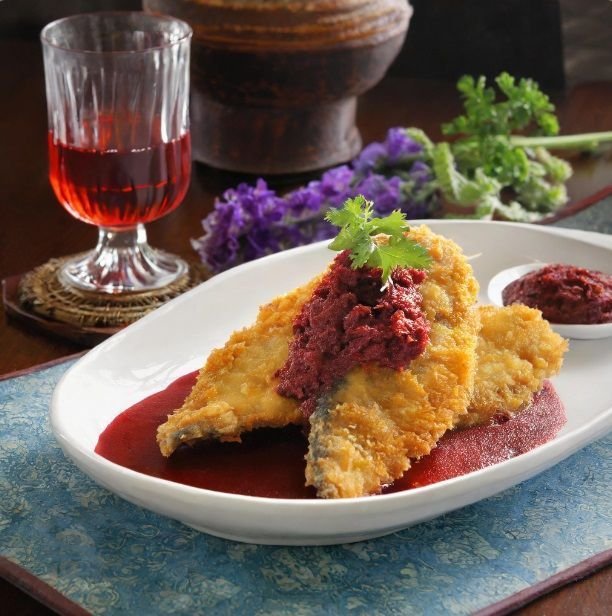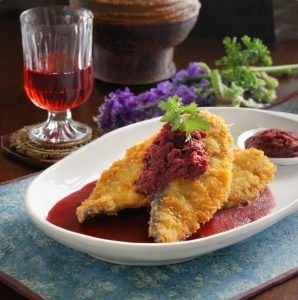
Fukienese Deep-Fried Fish with Red Wine Paste: A Step-by-Step East China Recipe
Deep-fried fish – deep fried fish recipe – deep fry fish – red wine – red wine paste – chinese recipes – sweet red wine – dry red wine
Fukienese deep-fried fish with red wine paste, also known as “Fujian Hongzao yu” (福建红糟鱼), is a delightful dish originating from the Fujian province in East China.
This recipe combines the succulence of fresh fish with the rich flavors of red wine paste, resulting in a mouthwatering dish that is both savory and aromatic. Follow this step-by-step guide to recreate this classic Fujianese delicacy in your own kitchen.
Ingredients:
For the fish:
- 1 whole fish (such as sea bass or red snapper), cleaned and scaled
- Salt, to taste
- White pepper, to taste
- Cornstarch, for dusting
For the red wine paste:
- 3 tablespoons red rice wine paste (hong zao)
- 2 tablespoons soy sauce
- 1 tablespoon Shaoxing wine (or dry sherry)
- 1 tablespoon honey
- 1 teaspoon sesame oil
- 2 cloves garlic, minced
- 1 teaspoon grated ginger
- 2 green onions, finely chopped
- 1 red chili, thinly sliced (optional)
For frying:
- Vegetable oil, for deep frying
For garnish:
- Fresh cilantro leaves
- Thinly sliced green onions
Instructions:
- Prepare the Fish:
- Rinse the whole fish under cold water and pat it dry with paper towels.
- Using a sharp knife, make several diagonal slashes on both sides of the fish, making sure to cut through to the bone. This will help the fish cook evenly and allow the marinade to penetrate.
- Season the Fish:
- Season the fish generously with salt and white pepper, both inside and out. Set aside while you prepare the red wine paste.
- Make the Red Wine Paste:
- In a bowl, combine the red rice wine paste, soy sauce, Shaoxing wine, honey, sesame oil, minced garlic, grated ginger, chopped green onions, and sliced red chili (if using). Mix well to combine.
- Marinate the Fish:
- Pour the red wine paste over the seasoned fish, making sure to coat it evenly, both inside and out. Use your hands to massage the marinade into the slashes you made earlier, ensuring that it penetrates the flesh.
- Let the Fish Marinate:
- Cover the fish with plastic wrap or aluminum foil and refrigerate for at least 30 minutes to allow the flavors to meld and the fish to absorb the marinade. You can marinate the fish for longer if desired, up to 2 hours.
- Heat the Oil for Frying:
- In a deep frying pan or wok, heat vegetable oil over medium-high heat until it reaches 350°F (180°C). You can test the oil temperature by dropping a small piece of bread into the oil—it should sizzle and turn golden brown within seconds.
- Fry the Fish:
- Dust the marinated fish lightly with cornstarch, shaking off any excess.
- Carefully lower the fish into the hot oil, using a slotted spoon or spider strainer to prevent splashing. Fry the fish for 8-10 minutes per side, or until golden brown and crispy, and the flesh is cooked through. The exact cooking time will depend on the size and thickness of the fish.
- Remove and Drain:
- Once the fish is cooked, carefully remove it from the oil using a slotted spoon or spider strainer. Transfer the fried fish to a wire rack or paper towels to drain off any excess oil.
- Serve:
- Transfer the fried fish to a serving platter and garnish with fresh cilantro leaves and thinly sliced green onions.
- Serve the Fukienese deep-fried fish with red wine paste hot, accompanied by steamed rice and your favorite stir-fried vegetables.
Tips for Success:
- Choose a fresh and firm whole fish for the best results. Sea bass, red snapper, or tilapia are all good options.
- Make sure the oil is hot enough before frying the fish to ensure a crispy exterior and juicy interior.
- Do not overcrowd the frying pan or wok—fry the fish in batches if necessary to maintain the oil temperature.
- Serve the fried fish immediately after cooking to enjoy it at its crispy best.
Fukienese deep-fried fish with red wine paste is a flavorful and aromatic dish that showcases the rich culinary heritage of the Fujian province in East China. With its succulent fish and savory red wine paste marinade, this dish is sure to impress your family and friends. Follow this step-by-step recipe and savor the delightful flavors of East China in the comfort of your own home.

Shaoxing Wine: The Magical Chinese Touch in Chinese Gastronomy
Shaoxing wine, known as “Shaoxingjiu” (绍兴酒) in Chinese, is a key ingredient in Chinese cuisine that adds depth, complexity, and a distinctive flavor profile to a wide range of dishes.
This traditional Chinese rice wine has a rich history dating back thousands of years and is cherished for its unique aroma, versatility, and ability to enhance the flavors of both savory and sweet dishes. In this article, we’ll delve into the cultural significance, production process, culinary uses, and health benefits of Shaoxing wine, exploring why it is considered the magical touch in Chinese gastronomy.
Cultural Significance:
Shaoxing wine has deep roots in Chinese culture and is an integral part of traditional Chinese culinary practices and social customs. It is believed to have originated in the Shaoxing region of Zhejiang province in Eastern China over 2,500 years ago, making it one of the oldest varieties of rice wine in the world.
In Chinese folklore and mythology, Shaoxing wine is associated with prosperity, longevity, and good fortune. It is often used in rituals and ceremonies to celebrate special occasions such as weddings, festivals, and the Chinese New Year. Additionally, it is a popular gift during festive seasons and is considered a symbol of friendship and hospitality.
Production Process:
Shaoxing wine is made from glutinous rice, water, yeast, and a small amount of wheat flour or barley. The production process involves fermenting and aging the rice mixture in large earthenware jars called “huadiao” over a period of several months to several years, depending on the desired flavor and quality.
During fermentation, the natural yeast present in the air and environment converts the starches in the rice into sugars, which are then transformed into alcohol. The wine is allowed to mature and develop its complex flavors, ranging from nutty and floral to slightly sweet and savory, as it ages in the clay jars.
The resulting Shaoxing wine is typically amber or reddish-brown in color, with a rich aroma and a slightly sweet, mellow flavor. It is classified into different grades based on factors such as production methods, aging duration, and alcohol content, with higher grades commanding higher prices and prestige.

Culinary Uses:
Shaoxing wine is a versatile ingredient that is used in a wide variety of Chinese dishes, from stir-fries and braises to soups and marinades. Its complex flavor profile adds depth and richness to both meat and vegetable dishes, making it an essential pantry staple in Chinese kitchens. Here are some common culinary uses of Shaoxing wine:
- Marinades and Sauces: Shaoxing wine is often used as a key ingredient in marinades and sauces to tenderize meat, enhance flavors, and add depth to dishes. It pairs well with ingredients such as soy sauce, ginger, garlic, and sugar, creating a savory and aromatic base for stir-fries, braises, and stews.
- Stir-fries: Shaoxing wine is frequently added to stir-fried dishes to impart a subtle sweetness and complexity to the flavors. It is typically drizzled over the ingredients early in the cooking process and allowed to evaporate, leaving behind a rich and aromatic sauce.
- Braises and Stews: Shaoxing wine is used in braised dishes and stews to tenderize meat, infuse flavors, and create a rich, velvety sauce. It is often combined with soy sauce, sugar, and aromatic spices like star anise and cinnamon to create classic Chinese braised dishes such as “red-braised pork” (hongshao rou) and “drunken chicken” (jiuji).
- Soups and Broths: Shaoxing wine is added to soups and broths to enhance the depth and complexity of flavors. It is typically used in small quantities to add a subtle sweetness and umami richness to the broth, complementing the other ingredients in the soup.
- Dumplings and Dim Sum: Shaoxing wine is sometimes used as a flavoring agent in dumpling fillings and dim sum dishes. It adds a subtle sweetness and depth of flavor to the filling, creating a delicious contrast to the savory ingredients.
Health Benefits:
In addition to its culinary uses, Shaoxing wine is also believed to have several health benefits when consumed in moderation. Some of the key health benefits of Shaoxing wine include:
- Improved Digestion: Shaoxing wine is often consumed as a digestive aid in Chinese medicine, as it is believed to stimulate digestion and promote the secretion of gastric juices.
- Cardiovascular Health: Some studies suggest that moderate consumption of Shaoxing wine may have beneficial effects on cardiovascular health, including lowering the risk of heart disease and improving blood circulation.
- Anti-inflammatory Properties: Shaoxing wine contains antioxidants and anti-inflammatory compounds that may help reduce inflammation in the body and alleviate symptoms of inflammatory conditions such as arthritis and gout.
- Stress Relief: In traditional Chinese medicine, Shaoxing wine is sometimes used as a stress-relieving tonic to help calm the mind and promote relaxation.
Shaoxing wine is truly the magical touch in Chinese gastronomy, adding depth, complexity, and a unique flavor profile to a wide range of dishes. With its rich cultural heritage, versatile culinary uses, and potential health benefits, Shaoxing wine remains an essential ingredient in Chinese kitchens and a symbol of Chinese culinary excellence. Incorporate this ancient rice wine into your cooking and experience the transformative power of Shaoxing wine in elevating the flavors of your favorite Chinese dishes.

RELATED POSTS
View all


